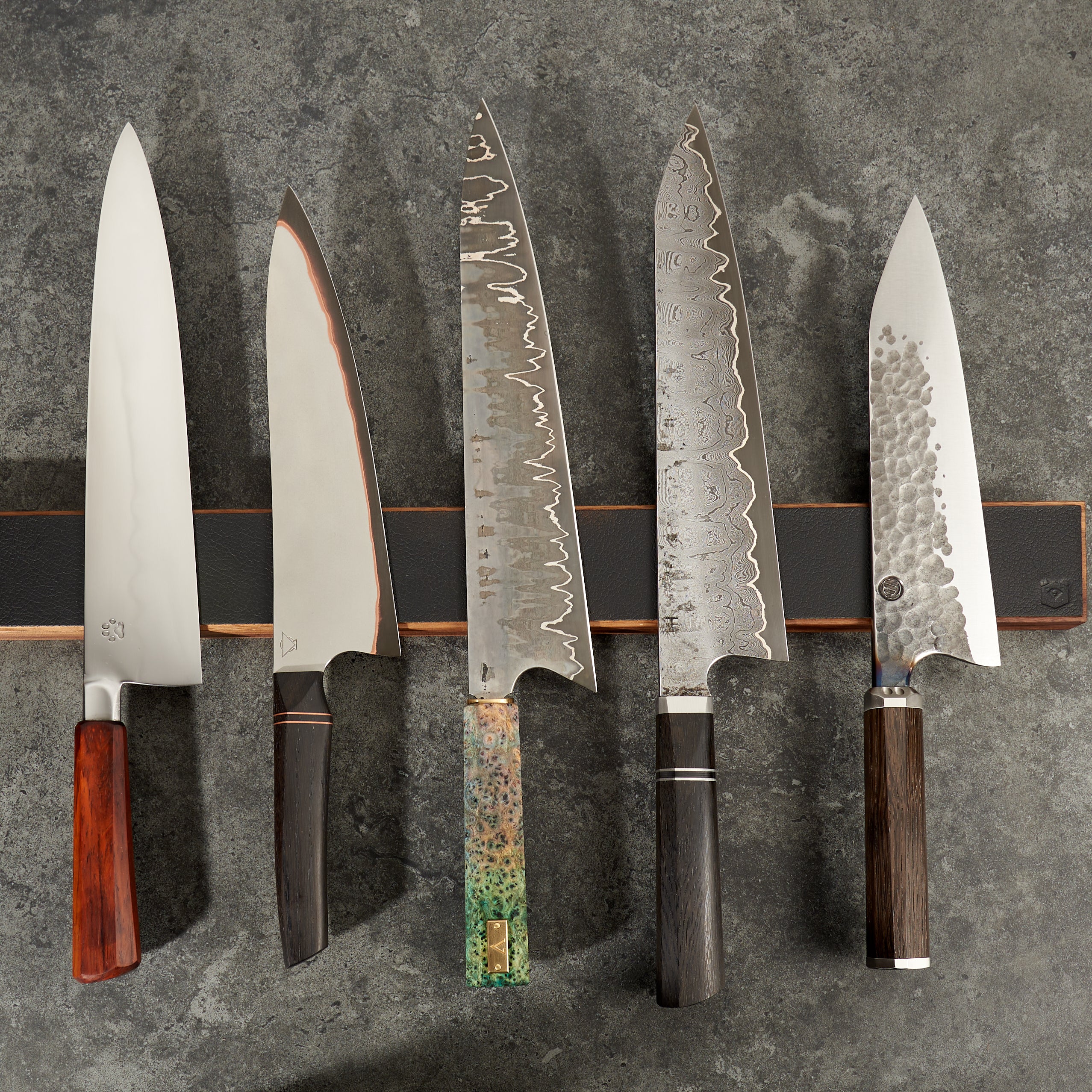In every cook’s life there will come a time when they become sick of using their cheap supermarket kitchen knives and feel the need to upgrade. Cheap knives, made with cheap steel always seem to be blunt, often have poor ergonomics and in the end yield poor results when it comes to fine knife work.
However, once you open Pandora’s box and begin to research high quality kitchen knives you are bombarded with endless information and questions. In the end it all boils down to personal comfort. However, usage and objectives can play a big roll on your decision and so throughout this series of articles we will be covering various aspects of what believe to be the most important weapon in the chef’s armory, the kitchen knife.
Disclaimer: the kitchen knife is not a weapon and should not be used as such. ;)
In this first article we will cover the basics of, price, construction materials, handles and blade balance as well as the essentials knife types every cook should have. If you’re just looking for some quick guidance on which knives every cook should have skip to the end and check out our guide on essential knives.
Price
Buying new kitchen knives is a complex and personal decision, but no buyers guide would be complete without a word on price. Based on our experience £100-£150 should get you a good quality French chef knife or Japanese Gyuto in a reasonable quality stainless steel.
However, as you will find it all depends on your needs. Better steels can yield better results in terms of sharpness and edge retention, better steels cost more money.
There is also craftsmanship, high-end, hand forged knives tend to have better ergonomics and balance and once again this will cost more money.
Finally, aesthetics, typically the hand forged blades simply look amazing and at a certain point your simple, practical kitchen knife can cease being a simple kitchen tool and become an artwork.
So, in the end the sky is the limit in terms of price, but we think £100-£150 is a good starting point if you are looking for something that will last a life time (with care) and maintain a reasonably sharp edge.
Construction – Materials – Balance
Generally speaking your standard kitchen knife consists of two main components, the blade and the grip or handle. Realistically these two components are all there is and all that matter. However, there are a huge variety of different handles and methods for constructing kitchen knife blades, not mention the myriad different shapes, and these will have a large impact on the ergonomics of the knife.
Handle
There are honestly too many different designs to count, but essentially, they come in two different forms. The most common handle type is the typical western style found on most of the famous brands like the those produced in Germany and other parts of western Europe. Then there are Japanese Wa handles, which have a cylindrical shape and tend to be longer in length than the typical western handle. Wa handles come in a D shape or a hexagonal/octagon shape both have a very comfortable feel to them. Some manufacturers have begun to develop other shapes and forms like the 3D handles on the VG10 range produced by Tanaka Kitchen Knives, which was developed in partnership with the Kobe Design University. The university used 3D modelling to map the human hand and developed a handle that would be both comfortable and suitable for professional use.
Knife handles come in a range of different materials like various woods, plastics and bonded materials. For most people this is not a big concern, but if you are working in a professional kitchen you may have some restriction or guide lines which you must abide by. Handles like the micarta handles on the Yaxell range of knives and the black plastic on the Güde knives are FDA and HACCP friendly. In the end handle material will affect two aspects of your purchasing decision. Looks and feel.
Blade
We’re not going to get too deep into blade construction in this article, but we will write a more detailed post in the future on the subject for those interested. Essentially there are a couple of factors you should concern yourself with and they are the blade hardness, and whether the blade is constructed out of Stainless or Carbon Steel.
The blade hardness will determine how durable the knife is and how sharp the blade can become. Blade hardness is measured on a hardness scale known as the Rockwell scale. The Rockwell scale measures the tensile strength of a material through applied force and the results are given as a numerical value which will typically range from about 58-68 in kitchen knives. 58 is pretty soft and 68 is really hard. Most good quality knives will be in the low 60s, 61-63 is pretty good.
Briefly, to understand what this all means. Harder steels are able to take a sharper edge and require sharpening less often, while softer steels are the opposite. However, it is also important to note that harder steels require more care with use as they will chip and become damaged if they are used to cut material like bone or hard, non-food products.
Stainless or Carbon Steel
Knives are manufactured with a such wide variety of difference steels there are too many to describe in this post. To cover the basics, you essentially need to know that they can all be broken down into two main categories, Stainless steel and Carbon Steel.
Stainless steel is actually not stainless, but stain resistant (some care is required). There are so many great stainless steels and really this is a good choice for anyone who is just beginning to learn about kitchen knives and the steels they are produced in. The advantages of stainless steel are obvious, they require less maintenance. In terms of Rockwell, the average hardness of stainless steels tends to be slightly lower than in carbon steels, but you can still get a very hard stainless-steel knife at a reasonable price, consider the RAN (HRC 61+) and GOU (HRC 62+) series by Yaxell kitchen cutlery or if you are looking for something super hard then check out the R2 series from Tanaka Kitchen Knives.
Carbon Steel on the other hand is not stain resistant, but it does have an average harness which is higher than stainless steel. There is an almost cult following with regard to carbon steel knives and those that enjoy using them will tell you that you can get a sharper edge on carbon, that they are easier to sharpen than stainless steel blades and that due to the hardness of the steel you can find thinner blades in carbon steel.
In our experience carbon steel knives are fantastically sharp and great to work with, but no more so than a great stainless steel. Stainless steel knives like the Kurosaki knives R2 range can be really hard (HRC 62+) and just as thin as a great carbon knife (approximately 2mm). As a chef the last thing you want to be doing is constantly caring for your blade. Our advice is to stick with stainless, but it really does boil down to person preference.
Balance
The length of the blade and the weight of the handle will determine how a blade is constructed. Knife manufacturers employ a range of methods to balance a knife. Some terms you might hear when discussing balance include full tang, half tang and distal taper.
In the end it is nice to have a blade that is centred on the point that you grip the knife. If you tend to use a pinch grip or a combo grip, then you will want this point to be over or slightly forward of the heal of the blade. If you use a regular/hammer or a pointed finger grip, then you will want the balance point to be slightly further back. Most chefs will employ a pinch or combo grip and as such most knives will be balanced over the heal of the blade.
Types – What do I need?
The Japanese have a myriad of different types from the Gyuto, Santoku and Petty to more obscure blade shapes like the Maguro bocho (Tuna Knife), Soba-giri bocho (Soba Noodle Knife) and Hamokiri (Conger Eel Knife). There are over 20 Japanese knife shapes and variations that we are aware of and surely many more. If you look at the western shapes you have the classic French Chef’s knife or Cook’s knife, Paring knives, the trusty Boning knife, Filleting knife, and many more and we haven’t even discussed the various Chinese shapes or those unique to other countries. So, do you need all of them? Certainly not.
Typically, a cook will only need a good French Chef’s knife or some variant like a Gyuto or Santoku, a Petty or small utility knife and a Paring knife. However, if you are regularly breaking down whole animals you may wish to look into a good Boning knife or Hankotsu in the case of fish a Japanese Deba and Yanagiba and in the case of vegetables a Nakiri or Usuba is a handy knife to have around, but in the end it comes down to the type of food you cook and the preparation you need to get down.
Gyuto, French Chef knife or Santoku?
The classic French chef knife and the Japanese Gyuto are very similar, both are long, wide blades with a very similar shape. The Chef knife is typically a long-curved blade with a flat section near to the heel, the Gyuto is a long flat blade with a curved section nearer to the tip.
The curved section on each blade allows for a rocking, slicing action. The flat section facilitates a chopping movement. So, regardless of your preferred style both knife types will essentially meet your needs. However, as you can guess Chef knives are designed with a preference for a rocking, slicing action and Gyuto is designed for of a more chopping style and slicing movement. If you tend to use a rocking action then you will prefer the Chef knife shape, if you tend to use a chopping action you will prefer the Japanese Gyuto.
The Santoku is a nice option if you are used to working with a shorter blade length (usually about 160mm-180mm), but in the end the shorter blade length is less versatile. Otherwise, Santokus have all the same features as the Gyuto, but the shorter blade length means they are not ideal for cutting through larger produce (water melons for example). However, being shorter actually makes the Santoku a nimbler blade to use. The blade height on a Santoku is the same as a Gyuto. So, as long as the produce you are cutting is shorter than the blade, which is 90% of what you would use a Gyuto for, its actually an easier knife to work with. For this reason, we use both in our kitchen and find that the Santoku is a little more fun and comfortable to use. Just as an aside the Santoku is usually a little cheaper than a French chef or Gyuto also.
Paring or Petty or Both?
A Paring knife is a short flat bladed knife usually about 8cm-10cm in length. This is a great knife for cleaning and preparing vegetables. The compact, short blade makes it perfect for fine detail work.
The Petty is a little bigger and mirrors the shape of a Gyuto, usually around 12cm-15cm. We think its handy to have both, but if you have to choose the Petty is capable of accomplishing everything the Paring knife can do in terms of vegetables and can also be used as a boning knife in a pinch, its slightly more versatile. However, the Paring knife is much easier to work with on those intricate jobs like peeling potatoes or lifting onion skins.


